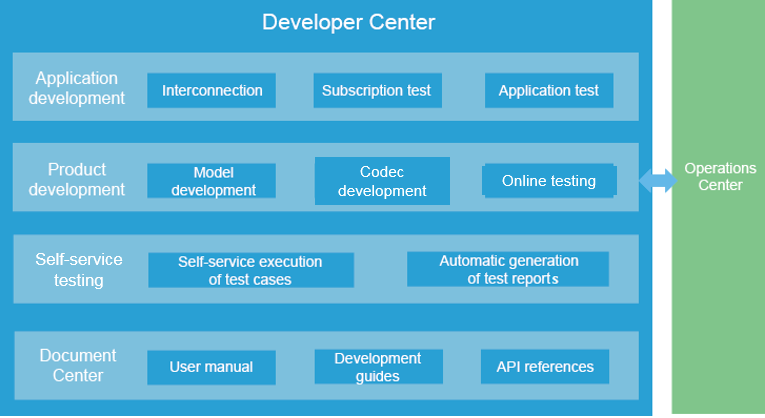Introduction to the Developer Center
As a one-stop IoT development tool platform, the Developer Center provides a variety of capabilities, such as product development, application development, self-service testing, and product release. It also provides resources such as development guides and API references to help developers improve integration development efficiency and shorten the construction period of IoT solutions.
Architecture of the Developer Center

Functions of the Developer Center
- Product Development: provides E2E development guides for profile definition, codec development, and product testing, facilitating quick launch of IoT products.
- Application Development: provides interconnection information, subscription tests, and application tests, helping developers develop and test applications and improve the independence of application development.
- Self-Service Testing: automatically tests product information, product models, and codecs, generates test reports, and checks whether the products meet the release standards.
- Document Center: provides online resources such as user manuals, development guides, and API references to provide real-time help.
- Product Release: interconnects with the Operations Center, enabling developers to apply for product release by one click after a product is tested in the Developer Center.
Related Concepts
- IoT Platform
The IoT platform integrates data, device, and operations management to implement unified and secure network access, flexible device adaptation, and data collection and analysis, thereby creating new values. The IoT platform provides open APIs for various industries to help partners quickly develop IoT service applications and meet personalized service requirements of customers. The IoT platform provides access for a variety of devices in wireless and wired access mode.
As a one-stop development tool platform based on the open capabilities of the IoT platform, the Developer Center helps developers quickly build an IoT platform-based solution.

- Project
A project refers to the resource space of the IoT platform. Developers need to create independent projects based on their own industries before developing IoT products and applications in the project space.
- Product
A collection of devices with the same capabilities or features is called a product. In addition to physical devices, a product includes product information, product models (profiles), codecs, and test reports generated during IoT capability building.
- Product Model
A product model (also called profile) is used to describe the capabilities and features of a device. Developers construct an abstract model of a device by defining a profile file on the IoT platform so that the IoT platform can understand the services, properties, and commands supported by the device.
- Software Development Kit (SDK)
SDK is a set of development tools used by software engineers to create application software for specific software packages, software frameworks, hardware platforms, and operating systems. Generally, the SDK is used in developing applications on the Windows platform. SDK can provide API files for a programming language or complex hardware that communicates with an embedded system.
The IoT platform provides developers with SDK on the application side and device side to help them quickly integrate applications or devices.
- Message Queue Telemetry Transport (MQTT)
MQTT is an IoT transmission protocol designed for lightweight release/subscription message transmission. It aims to provide reliable network services for IoT devices in low-bandwidth and unstable network environments.
MQTTS refers to the combination of MQTT and SSL/TLS. The SSL and TLS protocols are used for encrypted transmission.
- Constrained Application Protocol (CoAP)
CoAP is a software protocol designed to enable simple devices to perform interactive communication on the Internet.
CoAPS refers to CoAP over DTLS. The DTLS protocol is used for encrypted transmission.
- Lightweight Machine to Machine (LWM2M)
LWM2M is an IoT protocol defined by Open Mobile Alliance (OMA). It is mainly applied to NB-IoT devices with limited resources (such as limited storage and power supply).
Feedback
Was this page helpful?
Provide feedbackThank you very much for your feedback. We will continue working to improve the documentation.See the reply and handling status in My Cloud VOC.
For any further questions, feel free to contact us through the chatbot.
Chatbot





